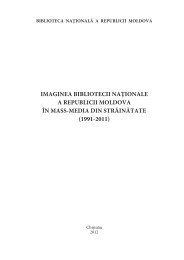download - Biblioteca NaÅ£ionalÄ a Republicii Moldova
download - Biblioteca NaÅ£ionalÄ a Republicii Moldova
download - Biblioteca NaÅ£ionalÄ a Republicii Moldova
Create successful ePaper yourself
Turn your PDF publications into a flip-book with our unique Google optimized e-Paper software.
Istorie<br />
Party in Chişinău, in 1917, initiated<br />
the establishment of professional<br />
and cultural societies, and took part<br />
in organizing the first congresses of<br />
<strong>Moldova</strong>n peasants, teachers, and<br />
clergymen. Elena Alistar founded<br />
the <strong>Moldova</strong>n Women’s Cultural<br />
League and was elected to represent<br />
the newly founded body in<br />
<strong>Moldova</strong>’s General Assembly, Sfatul<br />
Ţării, where, in 1918, she cast<br />
her vote in favor of Bessarabia’s<br />
union with Romania. She served<br />
as a principal of the Chişinău Lyceum<br />
for Girls (a.k.a. the Eparchial<br />
School),from which she herself<br />
had graduated under czarist rule,<br />
in 1890.Elena Alistar took refuge in<br />
Romania,where she settled after the<br />
Soviet annexation of Bessarabia, in<br />
June 1940.” (p. 32)<br />
„CALLIMACHI. Family of local<br />
<strong>Moldova</strong>n noblemen (originally named<br />
Călmaşu) who ruled over the<br />
Principality of <strong>Moldova</strong> during<br />
the last stages of the Phanariote<br />
era. Ioan Theodor Callimachi ruled<br />
between 1758 and 1761. He<br />
passed the throne on to his son<br />
Grigore Callimachi, who reigned<br />
twice, 1761-1764 and 1767-1769,<br />
at a time of dramatic escalation of<br />
the Russo-Turkish wars. His other<br />
son, Alexandru Callimachi, ruled the<br />
Principality of <strong>Moldova</strong> – by then a<br />
direct neighbor to the Russian Empire<br />
– between 1795 and 1799. The<br />
last ruler of the Callimachi dynasty<br />
was Scarlat Callimachi, who reigned<br />
briefly in 1806, at the outbreak of<br />
the 1806-1812 Russo-Turkish War;<br />
nominally between 1807 and 1810,<br />
under Russian occupation; and yet<br />
again between 1812 and 1819, after<br />
the Russian annexation of the eastern<br />
half of the principality under the<br />
terms of the Treaty of Bucharest<br />
of 1812. Scarlat Callimachi was the<br />
last ruling prince of <strong>Moldova</strong> in its<br />
traditional historical borders, with the<br />
principality straddling both banks of<br />
the Prut River (see BORDERS OF<br />
MOLDOVA). One of the accomplishments<br />
of Scarlat Callimachi’s reign<br />
was the publication of <strong>Moldova</strong>’s<br />
first civil code of laws (“Codul Callimachi”),<br />
inspired in great part by<br />
Austrian civil law ”( p. 67).<br />
„JUDEŢ. Traditional territorial<br />
and administrative unit of <strong>Moldova</strong><br />
(plural: judeţe), dismantled under<br />
Russia and Soviet rule and reestablished<br />
in 1999 only to be dismantled<br />
again in 2001. The 1999 law on<br />
<strong>Moldova</strong>’s territorial reform called<br />
for the reorganization of the territory<br />
into judeţe: Bălţi, Cahul, Chişinău,<br />
Edineţ, Lăpuşna, Orhei, Soroca,<br />
Tighina, and Ungheni, plus the<br />
autonomous territorial unit of Gagauz<br />
Yeri, and, later on, Taraclia.<br />
Soon after the 2001 parliamentary<br />
elections, the largest fraction in the<br />
<strong>Moldova</strong>n parliament, the Party of<br />
<strong>Moldova</strong>’s Communists, supported<br />
by the Braghiş Alliance,voted<br />
into law the return to the Soviet-era<br />
administrative structure of the country,<br />
consisting of raions. Prior to the<br />
1940 creation of the Moldavian Soviet<br />
Socialist Republic (MSSR),<br />
most of the territory covered by<br />
present-day <strong>Moldova</strong> was similarly<br />
divided into an equivalent number of<br />
judeţe, namely Bălţi, Cahul, Cetatea<br />
Albă, Hotin, Ismail, Lăpuşna, Orhei,<br />
Soroca, and Tighina.<br />
In terms of historical usage, the<br />
noun judeţ – equally in administrative<br />
use in Romania – is derived from<br />
jude, a traditional title meaning «judge»<br />
and, by extension, a local lord in<br />
charge of justice. See also RAION;<br />
ŢINUT.” (p. 198)<br />
“TRANSNISTRIA. The wartime<br />
area between the Nistru and<br />
the Bug rivers, dubbed Transnistria<br />
and passed over by Germany<br />
to Romanian administration under<br />
the Tighina Convention of 30 August<br />
1941, with George Alexianu<br />
as governor-general. According to<br />
the German-Romanian agreement,<br />
the province was placed under Romanian<br />
civil administration, with<br />
the German army high command in<br />
charge of giving instructions in the<br />
areas of security and the economic<br />
use of the territory. General Ion Antonescu<br />
unequivocally refused to<br />
annex Transnistria to Romania, to<br />
preclude any possible interpretation<br />
by Nazi Germany that such a deal<br />
would serve as compensation for<br />
Romania’s loss of Northern Transylvania<br />
awarded by Adolf Hitler to<br />
Horthyist Hungary in August 1940,<br />
barely a month after Bessarabia’s<br />
annexation by the Soviet Union under<br />
the provisions of the Molotov-<br />
Ribbentrop Pact.<br />
The territory of Transnistria was<br />
provisionally organized in 13 administrative<br />
districts: Ananiev, Balta,<br />
Berezovca, Dubăsari, Golta, Jugastru,<br />
Moghilev, Oceacov, Odessa,<br />
Ovidiopol, Râbniţa, Tiraspol, and<br />
Tulcin. Mass deportations of Jews<br />
from Bessarabia and Northern<br />
Bucovina were conducted in Transnistria<br />
between 1941 and 1943.<br />
Various statistics indicate that a<br />
total of 145,000 to 150,000 Jews<br />
were deported to Transnistria from<br />
various parts of Romanian-held<br />
territory, 56,089 of them from Bessarabia,<br />
others from Bucovina and<br />
other regions. Reportedly, about<br />
130,000 local Ukrainian Jews were<br />
also exterminated during the wartime<br />
occupation of Transnistria, to<br />
which statistics add at least 85,000<br />
deaths or exterminations of nonlocal<br />
Jewish deportees. Presumably, approximately<br />
50,000 Jews survived<br />
the Transnistria deportations.<br />
In contemporary usage, used<br />
in hyphenated form as a common<br />
noun, Transnistria is loosely applied<br />
to the self-proclaimed east-bank secessionist<br />
Moldavian Transnistrian<br />
Republic (MTR). See also WAR<br />
DEPORTATIONS” (p. 355).<br />
71
















